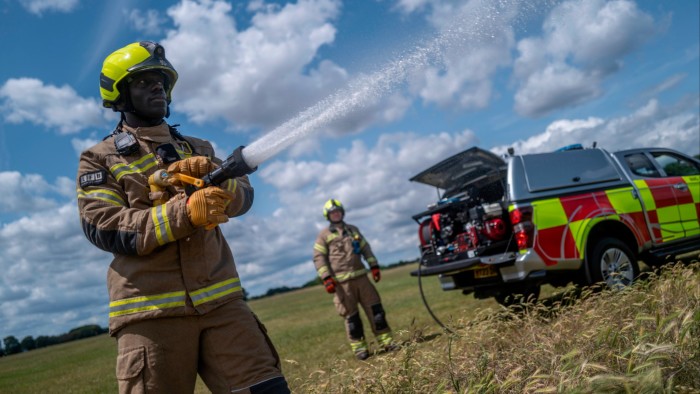Physical Address
304 North Cardinal St.
Dorchester Center, MA 02124
Physical Address
304 North Cardinal St.
Dorchester Center, MA 02124

London is at an increased risk of wildfires this summer, the UK capital’s fire service has warned, as it steps up efforts to prepare for blazes by investing in new equipment and sending firefighters on specialist training.
London Fire Brigade, which traditionally has fought property fires rather than those in vegetation, told the Financial Times it had been working with counterparts around the world to improve its response to wildfires.
Greater Manchester Fire and Rescue Service is among those that have travelled to Catalonia in Spain to learn how to tackle such blazes.
The capital was hit by a spate of wildfires that destroyed dozens of buildings on the UK’s hottest day on record in July 2022. Soaring temperatures across the summer led to 76 fires being reported in Epping Forest on the London-Essex border alone between June 26 and August 16 2022.
The unprecedented vegetation blazes on July 19 marked London Fire Brigade’s busiest day since the second world war.
Darren McLatchey, LFB deputy assistant commissioner, said that while wildfires had historically been uncommon in London, the risk was increasing because of climate change.
The driest spring in more than a century coupled with forecasts of a hot summer risked creating ideal conditions for blazes in the capital this year, he added.
“We are planning and anticipating that there is likely to be fires this year in open areas,” he said. “Climate change is having a very dramatic impact. In the last few years we have had a dramatic increase in fires in grass and open areas.”
While most wildfires in the UK are caused by human activity, scientists say climate change increases the risk and severity of such events by creating warmer, drier conditions. Drier vegetation linked to drought, for example, is more susceptible to ignition.
Other parts of the UK, such as Scotland, have already suffered an intense start to the wildfire season this year, as well as low rainfall.
A drought was declared in Yorkshire this week, following the north-west of England in May. Three other areas — the north-east and east of England and the West Midlands — are also experiencing prolonged dry weather, the Environment Agency has warned.

In addition to fire services across the country boosting efforts to better prepare for wildfires in recent years, the Forestry Commission has run specialist training for landowners, property managers and firefighters.
The non-ministerial government department for woodlands has filled about 1,800 places across five courses since 2021, and its next course is due to take place in July at Windsor Park in Berkshire.
In London, which is home to more than 100 fire stations, about 30 fire station commanders are now trained wildfire support officers, having participated in five days of specialist training. This included a trip to Northumberland, where the local fire service has more experience responding to open air blazes.
Since 2022, LFB said all London firefighters had undergone enhanced training on wildfires at the so-called urban-rural interface. The fire risks to people and property is greater in the area where green or forested spaces meet built-up spaces.
The service added that it was also running a pilot of four wildfire response vehicles, which have off-road capability and enable firefighters to use the water pump while driving, in contrast to traditional fire engines.
It also has wildfire beaters, long-handled, spade-like tools used to beat down grass fires; backpack blowers, which enable firefighters to push flames back into already burnt areas; and “holey hoses”, whose pre-prepared holes create a curtain of water.

Zack Polanski, Green party deputy leader and chair of the fire committee at the London Assembly, said LFB had learnt lessons from the “huge wildfires” of 2022, but concerns remained about preparedness for a large wildfire event.
He warned that the capital’s firefighters lacked lighter personal protection equipment commonly used when fighting wildfires across Europe. A trial of such PPE is taking place.
“Unless people have experienced it or seen it, [a wildfire] can seem like an abstract idea . . . People don’t realise how terrifying and how destructive it is,” he added. “We need to make our cities more resilient.”
Guillermo Rein, professor of fire science at Imperial College London, said the city’s extensive green areas, alongside suburban gardens that are often surrounded by tall wooden fences, made for plentiful fuel for a fire.
He also warned that stronger wind conditions than seen three years ago could cause worse damage.
“If we have a heatwave with a bit of wind, the fire brigade in London, unfortunately, will not be able to stop these fires. The probability of this is low . . . But we were very close to having a second great fire of London in 2022,” he said, referring to the devastating blaze of 1666.
A paper by Rein and colleagues published this year warned of so-called firewaves in London and other urban centres, triggered by heatwaves and dry conditions. The researchers linked waves of wildfires to vapour pressure deficit — a measure of the atmosphere’s ability to extract moisture from the land surface.
Rob Gazzard, chartered forester and surveyor at the Forestry Commission, said how fire services responded to wildfires was “only one part of the puzzle” in addressing the rising risk of forest and grass fires.
“What happens beforehand is critically important,” he said, pointing to the role of land managers and others in creating fire and fuel breaks during cooler periods of the year.
LFB’s McLatchey urged local authorities, councils and landowners to “manage the gap” between green areas and the urban environment by creating fire breaks, such as by cutting grass to a low level in the spaces near properties.